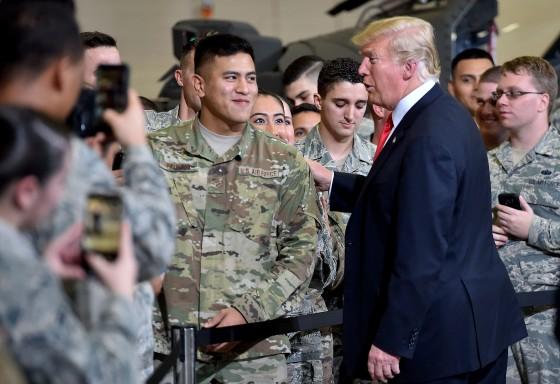Trump’s Military Deployment to the U.S.-Mexico Border: A New Chapter in Immigration Enforcement
Strategic Military Involvement to Strengthen Border Security
In a decisive effort to reinforce border security, former President Donald Trump authorized the deployment of military forces along the southern U.S. border. This initiative aims to assist border patrol agents in managing the increasing number of unauthorized entries and to deter criminal activities. Unlike direct law enforcement, the military’s role focuses on support functions such as surveillance, logistical aid, and infrastructure development, reflecting a calculated strategy to enhance border operations without escalating confrontations.
The executive directives emphasize several core components:
- Enhanced collaboration between the Department of Defense and the Department of Homeland Security to optimize border management.
- Advanced technological integration, including the deployment of drones and motion detection systems to monitor remote border regions.
- Infrastructure improvements through military engineering units to bolster physical barriers and border facilities.
| Military Unit | Primary Responsibility | Deployment Period |
|---|---|---|
| Surveillance Teams | Operation of aerial drones and remote monitoring | Initial 6 months |
| Engineering Battalions | Construction and reinforcement of border infrastructure | Up to 12 months |
| Logistics Units | Management of transport and supply chains | Initial 6 months |
Core Elements of Trump’s Border Enforcement Executive Orders
Trump’s executive orders delineate a comprehensive framework designed to tighten border security and reduce illegal immigration. Central to these orders is the authorization for increased military presence to augment border patrol capabilities, enhancing surveillance and rapid response along critical sectors of the border. This marks a notable shift toward a more militarized enforcement model, integrating the Department of Defense alongside Homeland Security in operational roles.
Additional key initiatives include:
- Expedited construction of border walls and fencing, prioritizing areas identified as high-risk by border officials.
- Deployment of cutting-edge surveillance technology such as drones and sensor networks for continuous border monitoring.
- Increased budget allocations to expand border enforcement personnel and resources.
| Provision | Feature | Anticipated Outcome |
|---|---|---|
| Military Support | National Guard and active-duty troops | Improved rapid response capacity |
| Border Barrier Expansion | New construction zones in vulnerable sectors | Decrease in unauthorized crossings |
| Technological Enhancements | Use of drones and motion sensors | Enhanced real-time surveillance |
Implications for Migrant Populations and Border Communities
The introduction of military forces at the border has raised significant concerns among migrant groups and human rights advocates. Many worry that increased militarization could escalate tensions and lead to more frequent confrontations, particularly impacting asylum seekers and refugees. Critics argue that a heightened military presence may intimidate vulnerable populations, discouraging them from pursuing legal avenues for protection and potentially worsening humanitarian conditions by diverting resources from essential social services.
Possible repercussions include:
- Interruption of family reunification efforts across the border
- Heightened obstacles for asylum applications due to stricter enforcement
- Increased risk of human rights infringements
- Additional pressure on local law enforcement and community support systems
| Group | Primary Concern | Potential Effect |
|---|---|---|
| Migrant Families | Risk of separation | Emotional trauma and diminished trust in authorities |
| Border Communities | Increased military presence | Economic disruption and social friction |
| Border Enforcement Agencies | Operational complexity | Resource reallocation and procedural slowdowns |
Guidance from Experts on Adapting to New Border Security Protocols
Security specialists stress the importance of understanding the scope and intent of the new border security measures for residents and travelers alike. The military deployment is designed to supplement, not replace, Customs and Border Protection (CBP) efforts. Experts recommend staying updated through official government sources to avoid misinformation and adhering to revised documentation and screening procedures, which have become more stringent under the new directives.
Recommended actions include:
- Monitoring changes in border crossing times and preparing for potential delays due to enhanced inspections.
- Utilizing official CBP digital platforms and mobile applications for real-time border status updates.
- Participating in local community briefings to understand the impact of these measures on daily transit and commerce.
| Focus Area | Suggested Action | Expected Benefit |
|---|---|---|
| Travel Documentation | Confirm validity and completeness before travel | Streamlined processing at checkpoints |
| Border Wait Times | Check official wait time reports regularly | Reduced uncertainty and better planning |
| Community Outreach | Attend informational sessions and forums | Enhanced preparedness and community support |
Conclusion: Navigating the Future of U.S. Border Security
The deployment of military forces to the southern border under Trump’s executive orders represents a marked intensification of the U.S. government’s approach to immigration enforcement. Proponents argue this strategy is vital for securing the border and reducing illegal crossings, while opponents caution against the potential erosion of civil liberties and the risks of militarizing domestic policy. As this complex and contentious issue continues to develop, staying informed about the evolving policies and their impacts remains essential. Our coverage will provide ongoing updates and thorough analysis to keep readers engaged with this critical national conversation.




